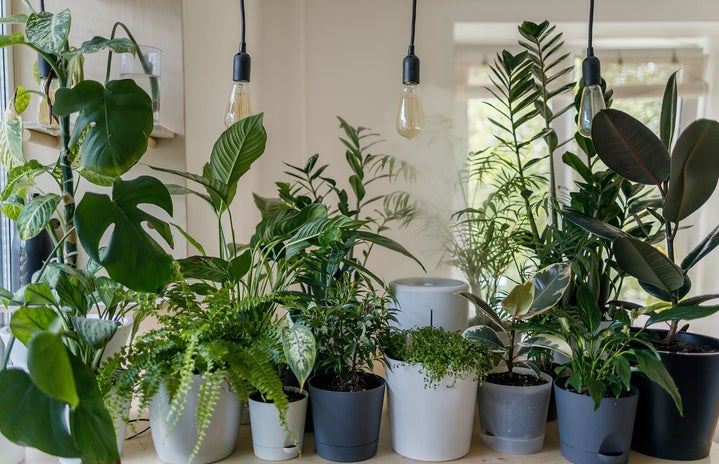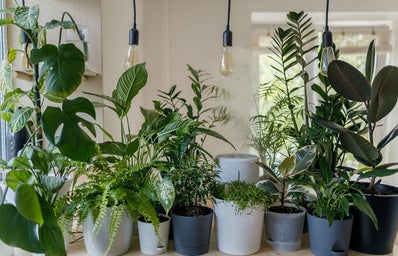Whether you enjoy a good study session or not, everyone knows that studying in the same, unchanging space can get a little stale. A stale space never makes a productive homework sesh!
With that being said, my favourite way to spice up a study space is by adding new plants. Their fresh pop of green and lively vibes always get me feeling fresh and ready to grind.
As a person who is very fond of houseplants, I’ve had dozens of them over the years (most of which are still living!). So, I’ve definitely gotten to know which ones are easy to care for, and which ones should be avoided at all costs.
Listed below are my top 5, all-time favourite houseplants that are versatile in what they can handle, and how they look.
- Pothos & pothos varieties
-
First up on the list, is the best plant and plant family out there. Pothos are extremely low maintenance, which is part of their charm. Being shade-tolerant and drought-tolerant are major pros for the plant world.
Along with those amazing characteristics, Pothos can grow extremely long vines and huge leaves if taken care of necessarily. They also have 20+ different styles! My personal faves are the Jade Pothos and Snow Queen Pothos.
I recommend that these be hung from the ceiling using durable hooks and macrame.
CARE
- Can handle no sun but will grow its best in a sunny window.
- Water when leaves begin to wilt, or when you feel that the top 2 inches of soil are dry.
- Classic cactus
-
Next up, everyone’s prickly friend, the cactus! Most of the time, these guys are bought pretty small (at least in my case) and are slow growers. This makes them perfect desk or shelf plants!
Unlike the Pothos, these do need direct sun to flourish, but they are extremely drought-tolerant! I usually leave mine on a sunny windowsill and forget about them for months at a time.
If you’re lucky, they may also occasionally flower! Unfortunately, they can be easy to over-water if it is done too frequently, so watch out!
CARE
- Needs direct sun to live, but can handle partial sun as well.
- Water when soil is at the absolute driest point.
- spider plant
-
Beautifully striped green and white, the Spider Plant made my top 5 by a landslide.
These plants are flowering, and self-reproducing! Every once in a while, if the plant is kept happy enough, it will grow a long vine that sprouts baby Spider Plants and flowers (Technically free plants? Yes please!).
Similarly to the Pothos, Spider Plants are drought-tolerant and shade-tolerant, growing best in areas that do not receive direct sunlight.
CARE
- Prefers areas with no direct sunlight.
- Water when leaves fade/wilt, or when the top 2 inches of soil are dry.
- Magnificent monstera deliciosa
-
Now for perhaps the biggest houseplant on my list, the gorgeous Monstera Deliciosa.
These plants come in a variety of sizes from small propagations, to huge, towering plants that live on a moss pole. For my list, I will be talking about the medium-sized version of these giants that could sit on a shelf, desk, or even on the floor.
With enough sunlight and space in the pot, Monsteras can grow green leaves the size of, or bigger than, your head (no moss pole necessary). If they get big enough, these leaves grow long slits and holes, called fenestrations, that only add to the beauty of this great plant.
Monstera Deliciosas are also relatively easy to care for. Requiring little water and no direct sun, they make the perfect study space plant.
CARE
- Prefers well-lit areas, but no direct sun.
- Water when the top two or three inches of soil are dry.
- African violet
-
Last on my list is the African Violet. I was hesitant to add this flowering plant to my list, but after looking at the one in my study space, I couldn’t leave this beautiful plant out!
African Violets are slightly more work than the plants mentioned above, but the little-labour they require is worth it.
These plants need to be watered frequently and do not take kindly to being ignored for long periods. I find that they can also be over-watered easily, so watering can be tricky.
Apart from their one-watering flaw, these plants thrive in the sun and are spring bloomers, coming in multiple shades of pink and purple. To get the most blooms from the African Violet, I recommend using a light fertilizer throughout the year.
CARE
- Require lots of light to grow.
- Water at the first sign of leaf-droopiness, no sooner or later.
- Light fertilizer aids in the production of flowers for spring.
With all said and done, it is up to you to go out and decorate your study space, and I hope that may include one of the plants listed above!


